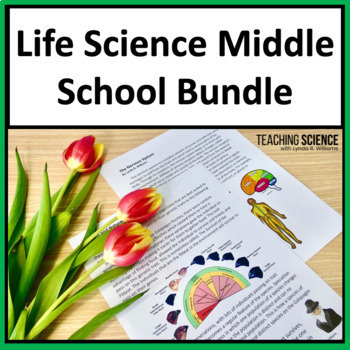Life Science Middle School Science NGSS 7th Grade Science Lessons Curriculum
- Zip

What educators are saying
Products in this Bundle (20)
showing 1-5 of 20 products
Bonus
Description
Do you teach life science in middle school? Perfect for 6th, 7th, and 8th Grade life science. Purchase this life science bundle and save 20%. This bundle covers all the life science standards for middle school NGSS. LS1: From Molecules to Organisms: Structures and Processes, LS2: Interactions, Energy, and Dynamics Relationships in Ecosystems, LS2: Interactions, Energy, and Dynamics Relationships in Ecosystems, and LS4: Biological Evolution: Unity and Diversity. Students will be engaged in learning about all the life science topics for middle school. Perfect for schools that have life science set in 7th Grade.
Benefits of this Bundle:
- phenomena-based
- engaging activities
- standards-aligned
Items included in this bundle:
- Lesson Plans
- Slide Shows
- Reading Passages
- Response Pages
- Labs
- Lab Pages
- Assessments
- Answer Keys
Teachers Love This Bundle!
Jessica ⭐️ ⭐️ ⭐️ ⭐️ ⭐️ Extremely Satisfied
"Students were engaged in meaningful activities that used phenomena and SEP. This bundle covered my whole year for NGSS 7th grade. The activities were great, and I really loved the reading passages and slide shows."
Covers these Disciplinary Core Ideas:
MS-LS1 From Molecules to Organisms: Structures and Processes
MS-LS2 Ecosystems: Interactions, Energy, and Dynamics
MS-LS3 Heredity: Inheritance and Variation of Traits
MS-LS4 Biological Evolution: Unity and Diversity
This Bundle Includes the following Units:
MS-LS1 From Molecules to Organisms: Structures and Processes
- Cells Structures and Function
- Sensory Receptors and The Nervous System
- Photosynthesis Complete Unit
- Circulatory System Unit
- Animal and Plant Adaptations
- Chemical Digestion and Cellular Respiration
Ecosystems: Interactions, Energy, and Dynamics
- Ecosystems: Patterns and Interactions
- Ecosystem Food Web Unit
- Evaluate Competing Designs for Maintaining Ecosystem Solutions
- Cycling of Matter and Flow of Energy
- Ecosystem Food Webs
Heredity: Inheritance and Variation of Traits
Biological Evolution: Unity and Diversity
- The Fossil Record Analyzing Patterns
- Natural Selection
- Comparing Anatomy and Embryology
- Selective Breeding
- Bird Adaptation Activities
- This bundle includes assessments in PDF and Google Forms.
- This bundle now includes a Jeopardy-style review game for life science
See the preview for more details!
Remember that leaving feedback earns you TPT points toward future purchases.
FOLLOW ME to be notified when new products are added. This is a huge bonus because my products are always 50% off for the first 24 hours they are posted
This resource is created by Lynda R. Williams.
You will love my other resources:
Claim Evidence Reasoning Unit for Middle School Science
Middle School Physical Science Bundle
My resources, including slide shows, are secure. This is for copyright reasons. These resources are in pdf and ppt format.





